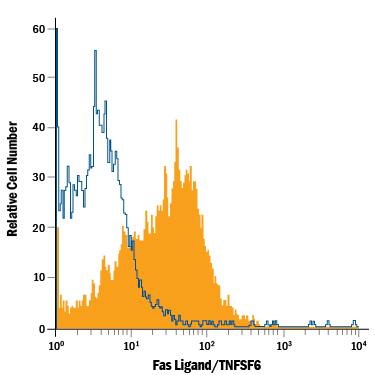Mouse Fas Ligand/TNFSF6 APC-conjugated Antibody
R&D Systems, part of Bio-Techne | Catalog # FAB526A


Key Product Details
Species Reactivity
Applications
Label
Antibody Source
Product Specifications
Immunogen
Pro132-Leu279
Accession # P41047
Specificity
Clonality
Host
Isotype
Scientific Data Images for Mouse Fas Ligand/TNFSF6 APC-conjugated Antibody
Detection of Fas Ligand/TNFSF6 in HEK293 Human Cell Line Transfected with Mouse Fas Ligand/TNFSF6 by Flow Cytometry.
HEK293 human embryonic kidney cell line transfected with mouse Fas Ligand/TNFSF6 was stained with Rat Anti-Mouse Fas Ligand/TNFSF6 APC-conjugated Monoclonal Antibody (Catalog # FAB526A, filled histogram) or isotype control antibody (Catalog # IC005A, open histogram). View our protocol for Staining Membrane-associated Proteins.Applications for Mouse Fas Ligand/TNFSF6 APC-conjugated Antibody
Flow Cytometry
Sample: HEK293 human embryonic kidney cell line transfected with mouse Fas Ligand/TNFSF6
Formulation, Preparation, and Storage
Purification
Formulation
Shipping
Stability & Storage
Background: Fas Ligand/TNFSF6
Fas Ligand (FasL) is a 40 kDa type II transmembrane protein belonging to the TNF super family. In the new TNF super family nomenclature, FasL is referred to as TNFSF6. The specific receptor for FasL is Fas (CD95, Apo-1), a 45 kDa type I transmembrane protein that is a member of the TNF receptor family. FasL is predominantly expressed on activated T cells and NK cells, while Fas is expressed on various types of cells. The Fas/FasL system plays a crucial role in modulating immune response by inducing cell apoptosis to maintain homeostasis, self-tolerance of lymphocytes, and immune privilege. FasL was reported to be a potent chemoattractant for neutrophils, suggesting a novel proinflammatory function of this molecule. Like other members of the TNF family, the membrane-bound FasL can be cleaved by metalloproteinase to generate a soluble Fas ligand (sFasL) which is mainly a non-covalently linked homotrimer. It has been shown that membrane-bound TNF‑ alpha and FasL are primary activators of their receptors. In contrast to soluble TNF‑ alpha which has potent cytotoxicity, sFasL is much less cytotoxic. Studies have shown that sFasL may competitively inhibit the killing effect of membrane FasL indicating that the cleaving of membrane FasL might be a mechanism to down‑regulate its activity. Over amino acids (aa) # 132-279, mouse FasL shares 83% aa sequence identity with human FasL.
References
- Suda, T. et al. (1993) Cell 75:1169.
- Kägi, D. et al. (1994) Science 265:528.
- Schneider, P. et al. (1998) J. Exp. Med. 187:1205.
- Seino, K. et al. (1998) J. Immunol. 161:4484.
Alternate Names
Gene Symbol
UniProt
Additional Fas Ligand/TNFSF6 Products
Product Documents for Mouse Fas Ligand/TNFSF6 APC-conjugated Antibody
Product Specific Notices for Mouse Fas Ligand/TNFSF6 APC-conjugated Antibody
For research use only